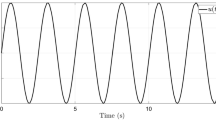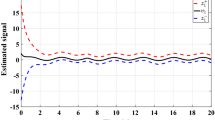Abstract
This paper considers the design of a Luenberger observer to estimate the linear multiple states functional for linear time-varying (LTV) systems. Based on the solutions to a type of full actuated homogeneous generalized Sylvester matrix equations and the conditions for the existence of observers for LTV systems, general parametric solutions to Luenberger functional observers are established. With the proposed approach, the functional observers can be achieved at desired convergence rate of the observation error, and also without any particular transformation for LTV systems. Finally, a numerical example shows the feasibility and effectiveness of the proposed parametric design method for the functional observers in LTV systems.
Similar content being viewed by others
References
K. Emami, H. Ariakia, and T. Fernando, “A functional observer based dynamic state estimation technique for grid connected solid oxide fuel cells,” IEEE Trans. on Energy Conversion, vol. 33, no. 1, pp. 96–105, March 2018.
T. Fernando, K. Emami, S. Yu, H. H. C. Iu, and K. P. Wong, “A novel quasi-decentralized functional observer approach to LFC of interconnected power systems,” IEEE Trans. on Power Systems, vol. 31, no. 4, pp. 3139–3151, July 2016.
P. Asthana, D. Narzary, and M. K. Sarkar, “Functional observer based higher order sliding mode control for DC-DC Buck converter,” Proc. of 2nd IEEE International Conference on Recent Trends in Electronics, Information & Communication Technology, pp. 1326–1330. 2017.
D. Luenberger, “An introduction to observers,” IEEE Trans. on Automatic Control, vol. 16, no. 6, pp. 596–602, December 1971.
D. Luenberger, “Observers for multivariable systems,” IEEE Trans. on Automatic Control, vol. 11, no. 2, pp. 190–197, April 1966.
T. Fortmann and D. Williamson, “Design of low-order observers for linear feedback control laws,” IEEE Trans. on Automatic Control, vol. 17, no. 3, pp. 301–308, July 1972.
J. Trumpf, On the Geometry and Parametrization of Almost Invariant Subspaces and Observer Theory, Dissertation, Universität Würzburg, 2002.
J. M. Schumacher, “On the minimal stable observer problem,” International Journal of Control, vol. 32, no. 1, pp.17-30, July 1980.
P. A. Fuhrmann and U. Helmke, “On the parametrization of conditioned invariant subspaces and observer theory,” Linear Algebra & Its Applications, vol. 332–334, pp. 265–353, August 2001.
F. Rotella and I. Zambettakis, “Minimal single linear functional observers for linear systems,” Automatica, vol. 47, no. 1, pp. 164–169, January 2011.
F. Rotella and I. Zambettakis, “A direct design procedure for linear state functional observers,” Automatica, vol. 70, pp.211-216, August 2016.
A. Z. Asanov and D. N. Dem’yanov, “Analytical synthesis of a functional observer of the state of a bilinear dynamic system,” Optoelectronics, Instrumentation and Data Processing, vol. 53, no. 4, pp. 329–336, July 2017.
T. Fernando and H. Trinh, “A procedure for designing linear functional observers,” Applied Mathematics Letters, vol. 26, no. 2, pp. 240–243, February 2013.
M. Darouach, “On the functional observers for linear descriptor systems,” Systems & Control Letters, vol. 61, no. 3, pp. 427–434, March 2012.
V. G. Volkov and D. N. Dem’yanov, “Functional observer design using linear matrix inequalities,” Optoelectronics, Instrumentation and Data Processing, vol. 52, no. 4, pp. 334–340, July 2016.
S. Ahmad, R. Majeed, K. S. Hong, and M. Rehan, “Observer design for one-sided Lipschitz nonlinear systems subject to measurement delays,” Mathematical Problems in Engineering, vol. 2015, 2015.
S. Wang, C. Gao, B. Jiang, and Y. Kao, “Robust finite-time control for neutral systems with time-varying delays via sliding mode observer,” International Journal of Control, Automation and Systems, vol. 15, no. 5, pp. 2099–2108. October 2017.
R. Galvan-Guerra, L, Fridman, and J. Davila, “High-order sliding-mode observer for linear time-varying systems with unknown inputs,” International Journal of Robust and Nonlinear Control, vol. 27, no. 14, pp. 2338–2356, October 2016.
Y. Shi, J. Ding, J. Lin, and Z. Gao, “Functional observer for switched discrete-time singular systems with time delays and unknown inputs,” IET Control Theory & Applications, vol. 9, no. 14, pp. 2146–2156, September 2015.
W. Y. Leong, H. Trinh, and T. Fernando, “A practical functional observer scheme for interconnected time-delay systems,” International Journal of Control, vol. 88, no. 10, pp. 1963–1973, April 2015.
H. Trinh and D. C. Huong, “A new method for designing distributed reduced-order functional observers of interconnected time-delay systems,” Journal of the Franklin Institute, vol. 355, no. 3, pp. 1411–1451, February 2018.
S. Bezzaoucha, H. Voos, and M. Darouach, “A new polytopic approach for the unknown input functional observer design,” International Journal of Control, vol. 91, no. 3, pp. 658–677, May 2016.
H. Trinh, T. Fernando, and S. Nahavandi, “Partial-state observers for nonlinear systems,” IEEE Trans. on automatic control, vol. 51, no. 11, pp. 1808–1812, Nov 2006.
C. Kravaris, “Functional observers for nonlinear systems,” IFAC-PapersOnLine, vol. 49, no. 18, pp. 505–510 August 2016.
L. T. L and G. R. Duan, “Full-state and reduced-order state observer design for a class of linear time-varying systems,” Chinese Automation Congress, pp. 2546–2551, 2017.
F. Mazenc, V. Andrieu, and M. Malisoff, “Design of continuous-discrete observers for time-varying nonlinear systems,” Automatica, vol. 57, pp. 135–144, July 2015.
R. E. H. Thabet, T. Raissi, C. Combastel, D. Efimov, and A. Zolghadri, “An effective method to interval observer design for time-varying systems,” Automatica, vol. 50, no. 10, pp. 2677–2684, October 2014.
L. Meyer, D. Ichalal, and V. Vigneron, “Interval observer for LPV systems with unknown inputs,” IET Control Theory & Applications, vol. 12, no. 5, pp. 649–660, March 2018.
G. R. Duan, Generalized Sylvester Equations: Unified Parametric Solutions, CRC Press, Boca Raton, 2015.
J. Trumpf, “Observers for linear time-varying systems,” Linear Algebra & Its Applications, vol. 425, no. 2–3, pp. 303–312, September 2007.
F. Rotella and I. Zambettakis, “On functional observers for linear time-varying systems,” IEEE Trans. on Automatic Control, vol. 58, no. 5, pp. 1354–1360, May 2013.
F. Rotella and I. Zambettakis, “A design procedure for a single time-varying functional observer,” Proc. of IEEE Conference on Decision and Control, IEEE 52nd Annual Conference on Decision and Control, pp. 800–804, 2013.
V. Lovass-Nagy, R. Miller, and R. Mukundan, “On the application of matrix generalized inverses to the design of observers for time-varying and time-invariant linear systems,” IEEE Trans. on Automatic Control, vol. 25, no. 5, pp.1213-1218, December 1980.
M. Ciampa and A. Volpi, “A note on smooth matrices of constant rank,” Rendiconti Dellistituto Di Matematica Delluniversita Di Trieste, vol. 37, no. 1, pp. 155–170, January 2005.
L. Dieci and T. Eirola, “On smooth decomposition of matrices,” Siam Journal on Matrix Analysis & Applications, vol. 20, no. 3, pp. 800–819, July 1999.
Author information
Authors and Affiliations
Corresponding author
Additional information
Recommended by Associate Editor Muhammad Rehan under the direction of Editor PooGyeon Park. This work was supported in part by National Natural Science Foundation of China (grant numbers 61333003, 61690212, 61690210).
Da-Ke Gu received the B.S. and M.S. degrees from the School of Automation Engineering at Northeast Electric Power University, Jilin, China in 2004 and 2007, respectively. He received the Ph.D. degree from the Department of Control Science and Engineering at Harbin Institute of Technology, Harbin, China in 2011. His current research interests include robust control, parametric control, quasi-linear systems and control applications in electric power systems.
Long-Wen Liu received the B.S. in the College of Electronic Information Engineering from Hebei University, Hebei, China in 2016, and now he is studying for a master’s degree in the School of Automation Engineering at Northeast Electric Power University, Jilin, China. His research interests include observer design, applications of positive systems, parametric method.
Guang-Ren Duan received his B.S. degree in Applied Mathematics, and both his M.S. and Ph.D. degrees in Control Systems Theory. From 1989 to 1991, he was a post-doctoral researcher at Harbin Institute of Technology, where he became a professor of control systems theory in 1991. He is currently the Director of the Centre for Control Systems and Guidance Technology at Harbin Institute of Technology. His main research interests include robust control, eigenstructure assignment, descriptor systems, missile autopilot control and magnetic bearing control. Prof. Duan is a Chartered Engineer in the UK, a Fellow of IEEE and IEE.
Publisher’s Note Springer Nature remains neutral with regard to jurisdictional claims in published maps and institutional affiliations.
Rights and permissions
About this article
Cite this article
Gu, DK., Liu, LW. & Duan, GR. A Parametric Method of Linear Functional Observers for Linear Time-varying Systems. Int. J. Control Autom. Syst. 17, 647–656 (2019). https://doi.org/10.1007/s12555-018-0155-1
Received:
Revised:
Accepted:
Published:
Issue Date:
DOI: https://doi.org/10.1007/s12555-018-0155-1




